
Baron Vladimir Harkonnen is a fictional character in the Dune franchise created by Frank Herbert. He is primarily featured in the 1965 novel Dune and is also a prominent character in the Prelude to Dune prequel trilogy (1999–2001) by Herbert's son Brian and Kevin J. Anderson. The character is brought back as a ghola in the Herbert/Anderson sequels which conclude the original series, Hunters of Dune (2006) and Sandworms of Dune (2007).
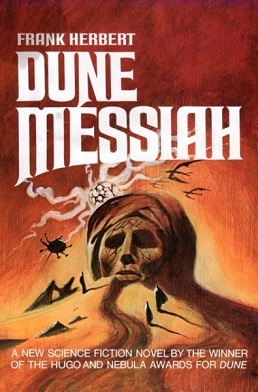
Dune Messiah is a 1969 science fiction novel by American writer Frank Herbert, the second in his Dune series of six novels. A sequel to Dune (1965), it was originally serialized in Galaxy magazine in 1969, and then published by Putnam the same year. Dune Messiah and its own sequel Children of Dune (1976) were collectively adapted by the Sci-Fi Channel in 2003 into a miniseries entitled Frank Herbert's Children of Dune.

Paul Atreides is a fictional character in the Dune universe created by Frank Herbert. He is a main character in the first two novels in the series, Dune (1965) and Dune Messiah (1969), and returns in Children of Dune (1976). The character is brought back as two different gholas in the Brian Herbert/Kevin J. Anderson novels which conclude the original series, Hunters of Dune (2006) and Sandworms of Dune (2007), and appears in the prequels Paul of Dune (2008) and The Winds of Dune (2009). According to Brian Herbert, Frank Herbert's son and biographer, House Atreides was based on the heroic but ill-fated Greek mythological house of Atreus.

Dune is a 1965 epic science fiction novel by American author Frank Herbert, originally published as two separate serials in Analog magazine. It tied with Roger Zelazny's This Immortal for the Hugo Award for Best Novel and won the inaugural Nebula Award for Best Novel in 1966. It is the first installment of the Dune Chronicles. It is one of the world's best-selling science fiction novels.
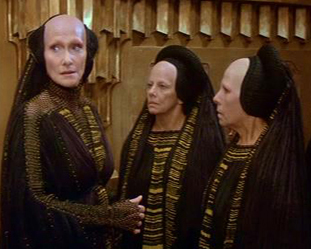
The Bene Gesserit are a group in Frank Herbert's fictional Dune universe. A powerful social, religious, and political force, the Bene Gesserit is described as an exclusive sisterhood whose members train their bodies and minds through years of physical and mental conditioning to obtain superhuman powers and abilities that seem magical to outsiders. The group seeks to acquire power and influence to direct humanity on an enlightened path, a concerted effort planned and executed over centuries.

Gurney Halleck is a fictional character in the Dune universe created by Frank Herbert. He is a major character in Herbert's Dune (1965) and Children of Dune (1976) as the War Master of House Atreides, acting as mentor, friend, and advisor to Paul Atreides. He also appears in some of the prequel/sequel novels by Brian Herbert and Kevin J. Anderson.

Duncan Idaho is a fictional character in the Dune universe created by Frank Herbert. He was introduced in the first novel of the series, 1965's Dune, and became a breakout character. He was revived in 1969's Dune Messiah. He is the only character to feature in all six of Herbert's original Dune novels.

Lady Jessica is a fictional character in the Dune universe created by Frank Herbert. A main character in the 1963–65 novel Dune, Jessica also plays an important role in the later installment Children of Dune (1976). The events surrounding Jessica's conception, her birth and her early years with Leto are chronicled in the Prelude to Dune prequel trilogy (1999–2001) and the Caladan Trilogy (2020–2022) by Brian Herbert and Kevin J. Anderson. The character is brought back as a ghola in the Herbert/Anderson sequels which conclude the original series, Hunters of Dune (2006) and Sandworms of Dune (2007).

Alia Atreides is a fictional character in the Dune universe created by Frank Herbert. She was introduced in the first novel of the series, 1965's Dune, and was originally killed in Herbert's first version of the manuscript. At the suggestion of Analog magazine editor John Campbell, Herbert kept her alive in the final draft. Alia would next appear as a main character in both Dune Messiah (1969) and Children of Dune (1976). The character is brought back as a ghola in the Brian Herbert/Kevin J. Anderson conclusion to the original series, Sandworms of Dune (2007).
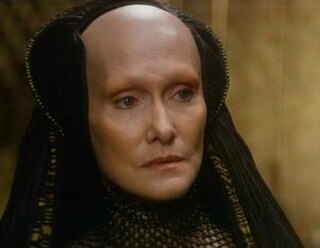
Gaius Helen Mohiam is a fictional character in the Dune universe created by Frank Herbert. She is a Bene Gesserit Reverend Mother, and initially appears in the 1963–65 novel Dune and its 1969 sequel, Dune Messiah. Mohiam also has a major role in the Prelude to Dune prequel trilogy (1999–2001) and the Caladan Trilogy (2020–2022) by Brian Herbert and Kevin J. Anderson.
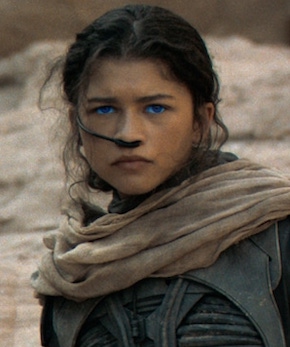
Chani is a fictional character featured in Frank Herbert's novels Dune (1965) and Dune Messiah (1969). Known mainly as the Fremen wife and legal concubine of protagonist Paul Atreides, Chani is the daughter of Imperial Planetologist Liet-Kynes and his Fremen wife Faroula, and later the mother of the twins Ghanima and Leto II Atreides. The character is later resurrected as a ghola, appearing in Hunters of Dune (2006) and Sandworms of Dune (2007), Brian Herbert and Kevin J. Anderson's novels which complete the original series.

Princess Irulan is a fictional character in the Dune universe created by Frank Herbert. She first appears in Dune (1965), and is later featured in Dune Messiah (1969) and Children of Dune (1976). The character's birth and early childhood are touched upon in the Prelude to Dune prequel trilogy (1999–2001) by Herbert's son Brian, and Kevin J. Anderson, and she is a principal character in the Herbert/Anderson series Heroes of Dune (2008–2009).
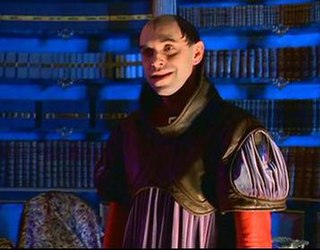
Count Hasimir Fenring is a fictional character in the Dune universe created by Frank Herbert. He is featured in the 1965 science fiction novel Dune by Frank Herbert, and is also a key character in the Prelude to Dune trilogy by Brian Herbert and Kevin J. Anderson. He later appears in the 2008 novel Paul of Dune, and the Caladan Trilogy (2020–2022).
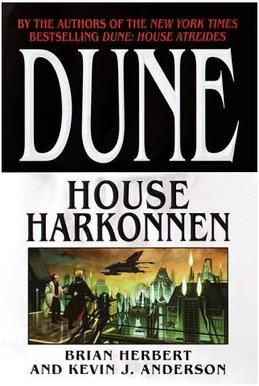
Dune: House Harkonnen is a 2000 science fiction novel by Brian Herbert and Kevin J. Anderson, set in the fictional Dune universe created by Frank Herbert. It is the second book in the Prelude to Dune prequel trilogy, which takes place before the events of Frank Herbert's celebrated 1965 novel Dune. The Prelude to Dune novels draw from notes left behind by Frank Herbert after his death.

Dune is an American science fiction media franchise that originated with the 1965 novel Dune by Frank Herbert and has continued to add new publications. Dune is frequently described as the best-selling science fiction novel in history. It won the inaugural Nebula Award for Best Novel and the Hugo Award in 1966 and was later adapted into a 1984 film, a 2000 television miniseries, and a two-part film series with the first film in 2021 and a sequel in 2024. Herbert wrote five sequels, the first two of which were concomitantly adapted as a 2003 miniseries. Dune has also inspired tabletop games and a series of video games. Since 2009, the names of planets from the Dune novels have been adopted for the real-world nomenclature of plains and other features on Saturn's moon Titan.

Feyd-Rautha Harkonnen is a fictional character in the 1965 science fiction novel Dune by Frank Herbert. He is the younger nephew and heir of the Baron Vladimir Harkonnen, and is depicted to be cruel, treacherous and cunning, though not as much so as his uncle.

Frank Herbert's Children of Dune is a three-part science fiction television miniseries written by John Harrison and directed by Greg Yaitanes, based on Frank Herbert's novels Dune Messiah (1969) and Children of Dune (1976). First broadcast in the United States on March 16, 2003, Children of Dune is the sequel to the 2000 miniseries Frank Herbert's Dune, and was produced by the Sci Fi Channel. Children of Dune and its predecessor are among the highest-rated programs ever to be broadcast on the Sci-Fi Channel. In 2003, Children of Dune won a Primetime Emmy Award for Outstanding Special Visual Effects, and was nominated for three additional Emmys.

Margot, Lady Fenring is a fictional character from the Dune universe created by Frank Herbert. She is featured in Herbert's Dune (1965), and is a major character in the Prelude to Dune prequel trilogy (1999–2001) and the 2008 novel Paul of Dune by Brian Herbert and Kevin J. Anderson. She later appears in the Caladan Trilogy (2020–2022). Margot is the Bene Gesserit wife of Count Hasimir Fenring, a close friend of the Padishah Emperor Shaddam IV, but is loyal to the Sisterhood.

The Dune prequel series is a sequence of novel trilogies written by Brian Herbert and Kevin J. Anderson. Set in the Dune universe created by Frank Herbert, the novels take place in various time periods before and in between Herbert's original six novels, which began with 1965's Dune. In 1997, Bantam Books made a $3 million deal with the authors for three Dune prequel novels, partially based upon notes left behind by Frank Herbert, that would come to be known as the Prelude to Dune trilogy. Starting with 1999's Dune: House Atreides, the duo have published 15 Dune prequel novels to date.



















